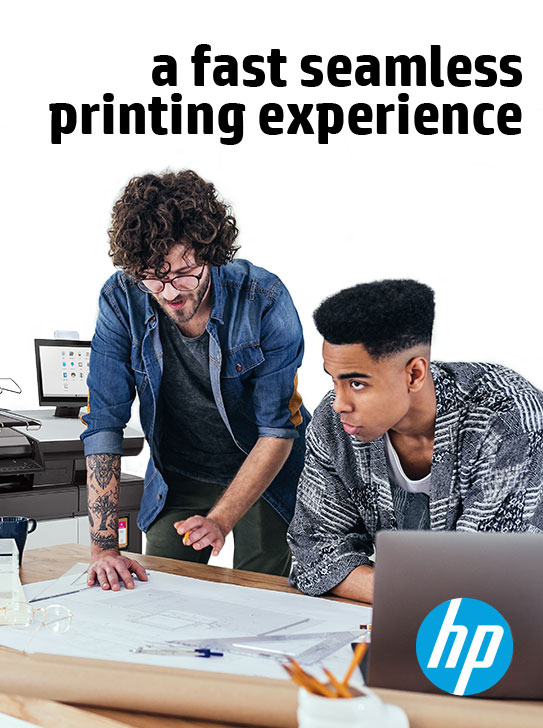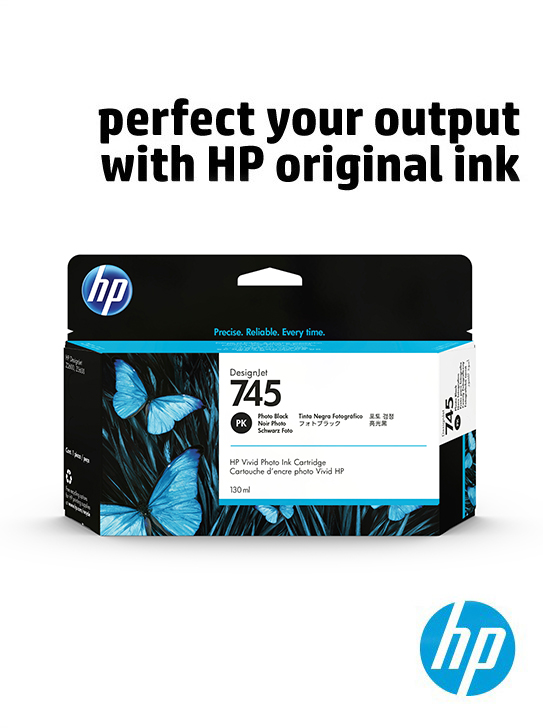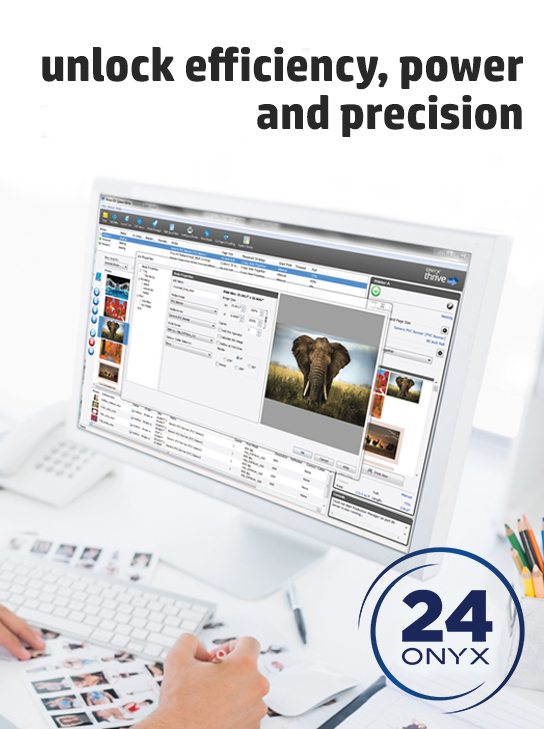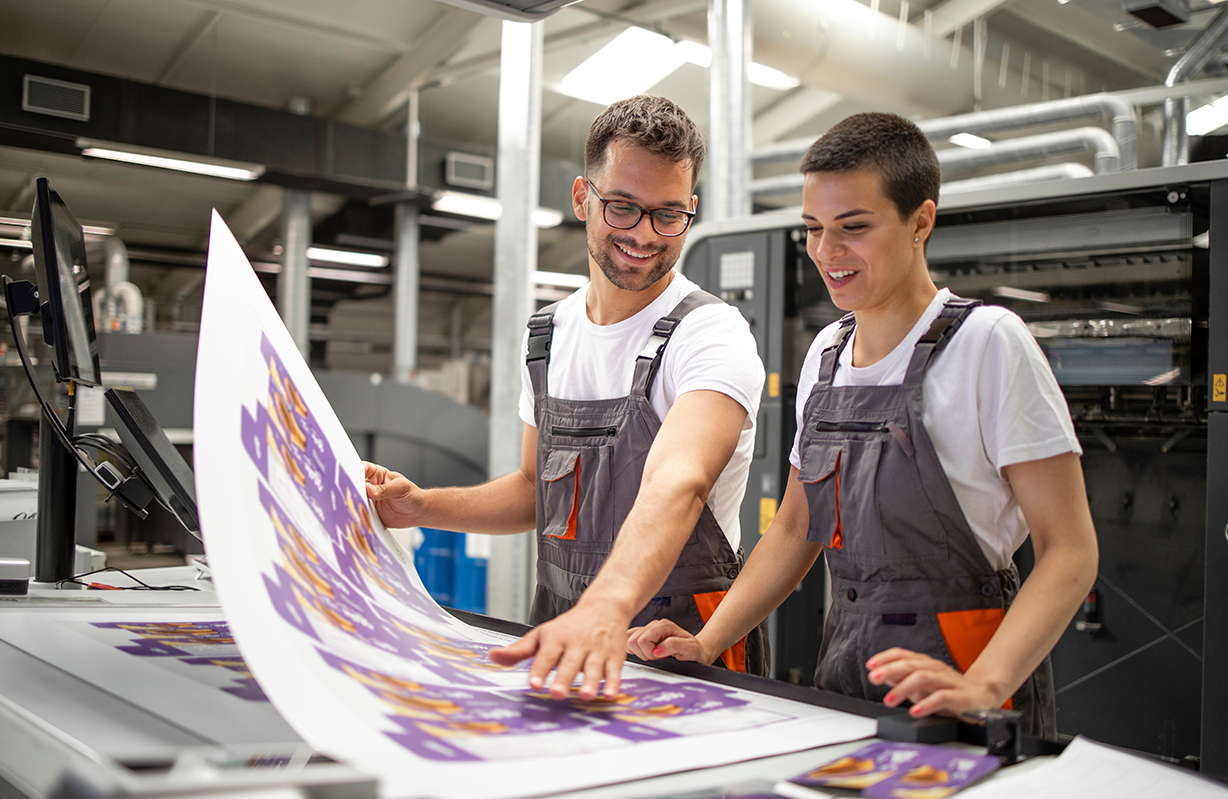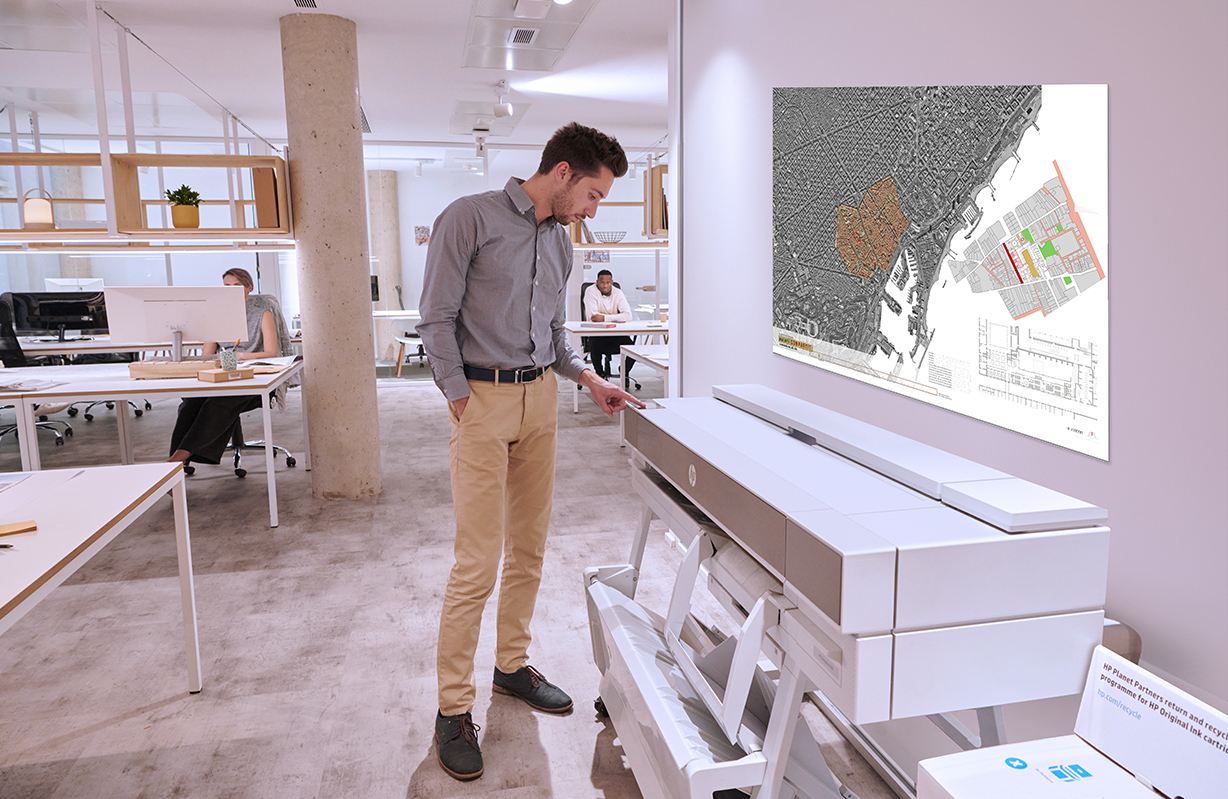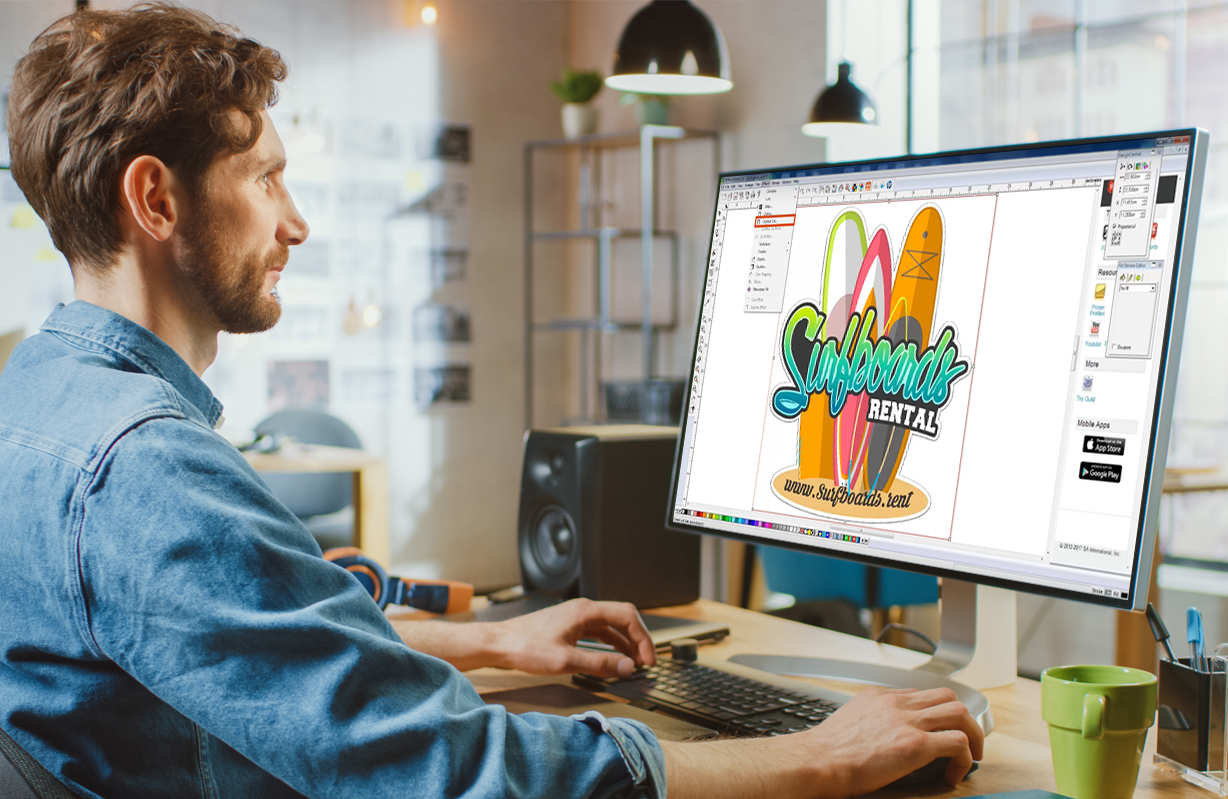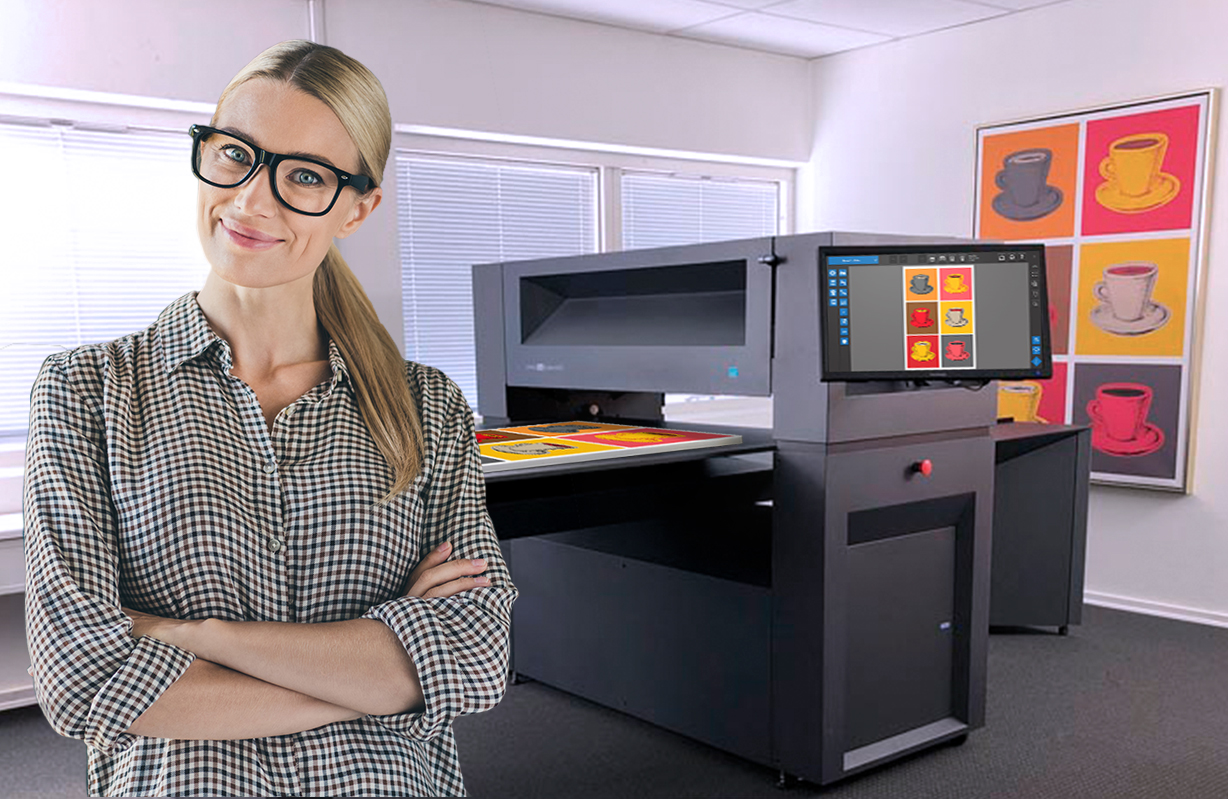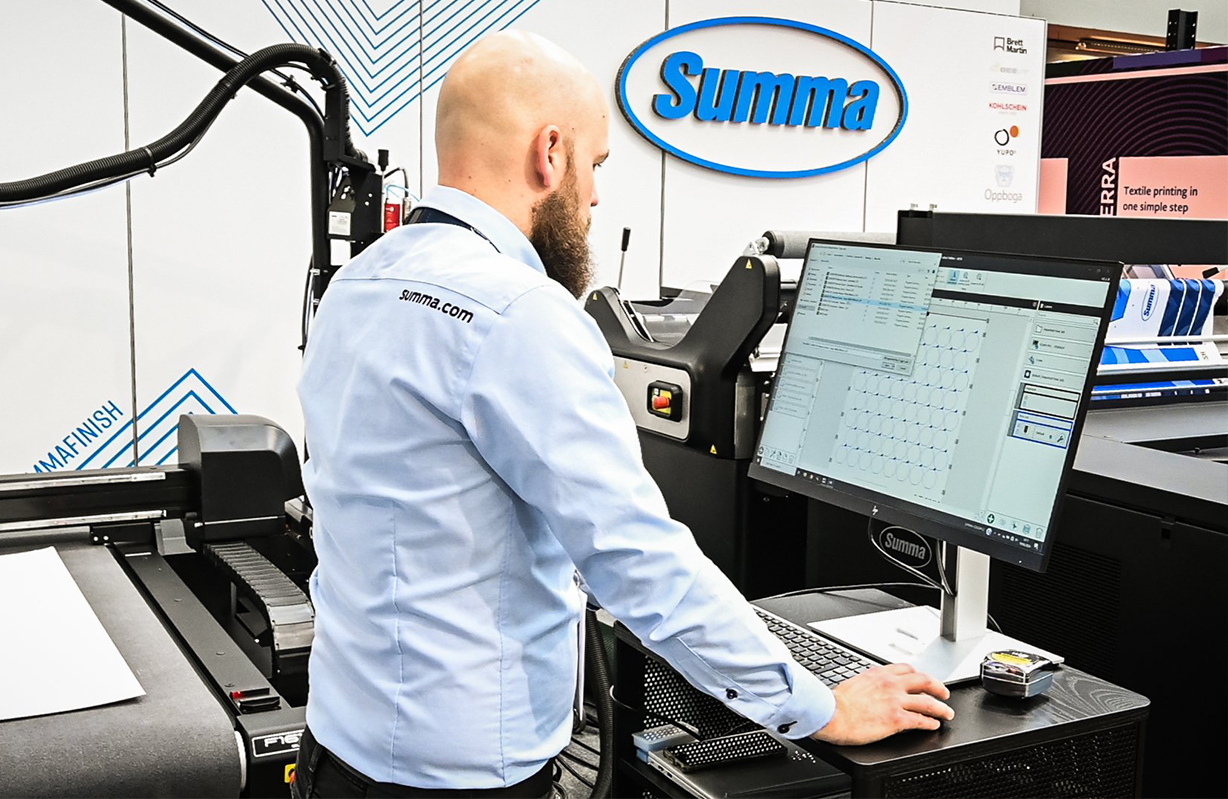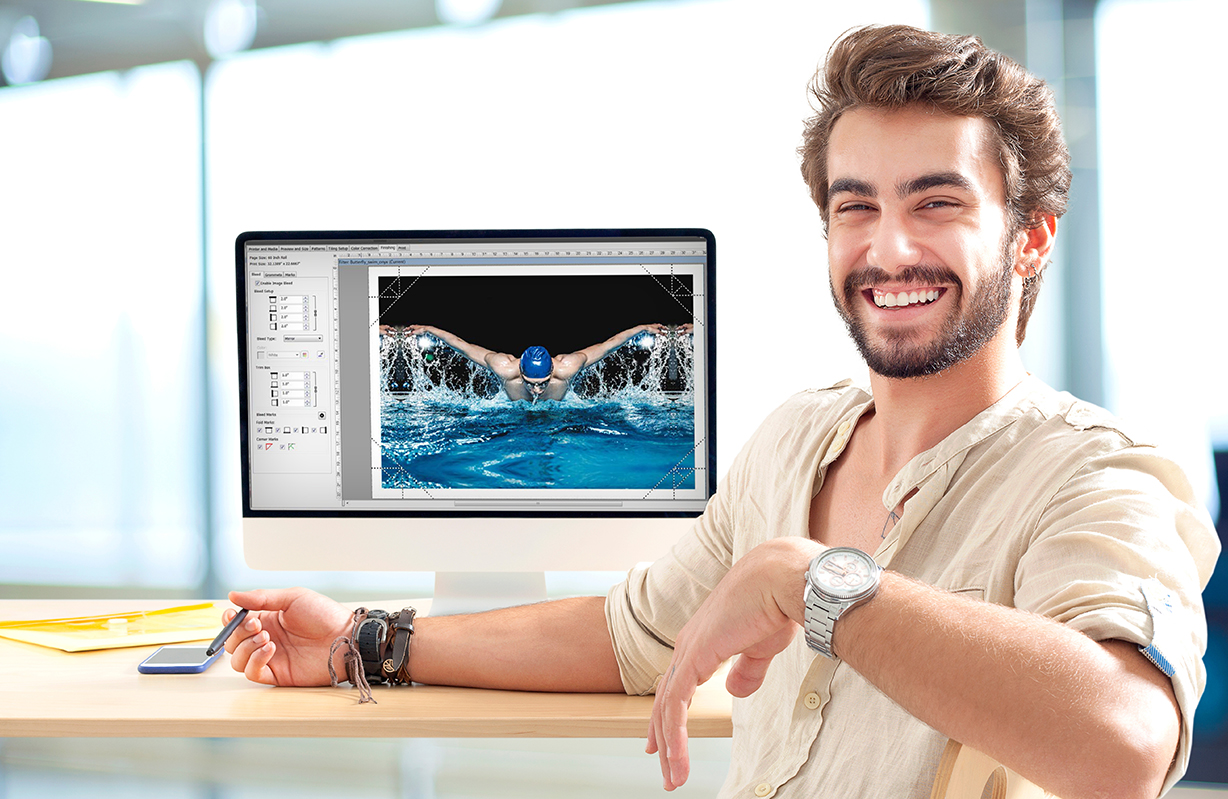-
Read more ...
Technical documents are a cornerstone of any architecture, engineering and construction (AEC) office. Ask any designer, architect or engineer: they facilitate collaboration with stakeholders located near and far — from concept design stage through to the completed construction project.
When looking for the right architectural printer, one that doesn’t meet specific requirements can lead to many complications. With tenders, presentations, and deadlines hinging on smooth project flows, it is imperative that you get the right printer best suited to the needs of your practice. If you have ever received an internal email with instructions not to send any jobs to the printer because a tender is due, then you understand what we are trying to say.
So, what should you look for?
In short, the right printer can help you:
- Streamline workflow
- Enable collaboration across departments
- Support a more agile work culture
Time is money
The golden rule is to never waste any time. The faster the print job, more time can be spent on core activities. Two areas to look out for, whatever architectural printer you choose, are:
- The time the printer takes to warm up from standby mode to begin printing.
- The time it takes to complete the first and subsequent prints, known as “throughput time”.
Speed is often listed in terms of images per minute (IPM) and pages per minute (PPM). For large format printers, PPM is typically given in terms of A1 sheets, as opposed to A4/letter sheets in standard printers.
Up to 0.1% line accuracy precision
For architectural printers, every little detail matters. They are designed to produce highly accurate drawings, and precision measurements are generally measured in two ways. Line accuracy is given in “ per cent”, denoting the margin of placement error that a printer allows. This refers to the distance between the printed line and the line’s position on the original file. The smaller the figure, the higher the accuracy.
Guaranteed minimum line width is given in millimetres and describes the lightest line weight a printer is capable of representing. Similarly, the lower the figure, the higher the accuracy, meaning that even very fine line weights will be preserved.
Depending on the type of technical drawing, the line weight (better known as pen width) is assigned to the graphical elements in CAD and needs to be consistent with all technical drawings produced.
Compatible with all modelling software
Imagine making several rounds of changes to the 3D model in preparation for a tender submission. When reviewing the prints, you discover that several layers were not printed as intended, because the printer driver, or the printer, is not compatible with your 3D application. With the number of CAD platforms used, this scenario is very plausible.
While some CAD platforms are widely used within the AEC industry, there is none that can meet every requirement or purpose. Accordingly, not all of these will be compatible with your chosen large format printer.Makes work much easier
Ever struggled to locate the ink cartridge ports in your architectural printer? Had difficulties with sending your print jobs to the printer? Frustrated with collecting prints off the floor? The good news is that modern large format printers enable workflow efficiency to be improved.
For instance, easy paper and ink loading, as well as neat stacking and collation of completed prints all help to save time, contributing to a smoother process.
Always depend on hard copy
No project is safe from delays. There are multiple reasons for downtime, from remoteness or inaccessibility of field sites, or sudden bad weather. Connectivity in such places may be fair at the best of times, but it can disappear in a second. In such situations, hard copy is always reliable and dependable.
Today, large format printers are more cost-effective than ever, producing documents with higher resolution and colour fidelity. The right ones can help you do more than you can imagine.
-
Read more ...
If you need to print high-quality, large-scale posters or banners, you likely understand the importance of selecting the best poster printer to complete the job. Specifically, what you'll want is a top-end plotter printer that can optimise quality and detail with each printout. However, with so many options available, you might not know which printer will work best for you.
To help you find the right solution, we've compiled a list of some of the top poster printers on the market today. We've carefully examined their features, customer reviews, and cost to determine which equipment is best for large-format poster printing in 2024. We hope our insights will help you make the best selection to provide you with consistently great quality.
2024 large format printing trends to look out for
When shopping for a large-format plotter printer, some trends in this industry are worth noting.
In addition to an industrial poster printer machine, you may have access to certain benefits that facilitate a safe work environment due to the lasting effects of the COVID-19 pandemic. Amid the pandemic, brands like HP and others, have offered extended warranties and remote customer support while promoting various work-from-home initiatives.
Check to see if your large-format poster printing equipment manufacturer offers these benefits as you shop for the perfect solution.
What to consider when buying a plotter for large-format poster printing
When choosing a plotter printer for large-format poster printing, consider the following factors:
a) Printing speed
You'll want to find a highly-efficient industrial poster printer machine to save you more time. Manufacturers typically detail the estimated speed of their printers to give you a good sense of their efficiency.
b) Resolution quality
Consider the resolution quality you need for your posters and other print jobs. You can find large format poster printers with resolutions as high as 2880 x 1440 dots per inch (dpi), and many can print a wide range of colours.
c) Print-size capacity
The printer size will also depend on the size of your projects. Choose a plotter printer that can handle the intended print size. But also consider your space requirements and how they may affect the placement of the printer.
d) Type of ink used
Decide whether you want a poster printer machine that uses water-based or solvent-based inks. Water-solvent inks tend to be more costly and are ideal for indoor applications. Meanwhile, you might want solvent-based ink printers to save money and withstand exposure to outdoor elements. Also, dye inks offer bright picture quality but don't hold up well in sunlight while pigment-based inks often withstand outdoor exposure with the downside of increased dullness.
e) The cost
Another key factor is the cost of the printer, including the initial purchase and maintenance. Set a budget for your printer, and don't buy the cheapest printer you find, as higher initial costs may translate to lower ongoing expenses due to reduced maintenance.
5 best poster printers for large-format printing in 2024
The following are some of the top plotter printers for large-format poster printing available today:
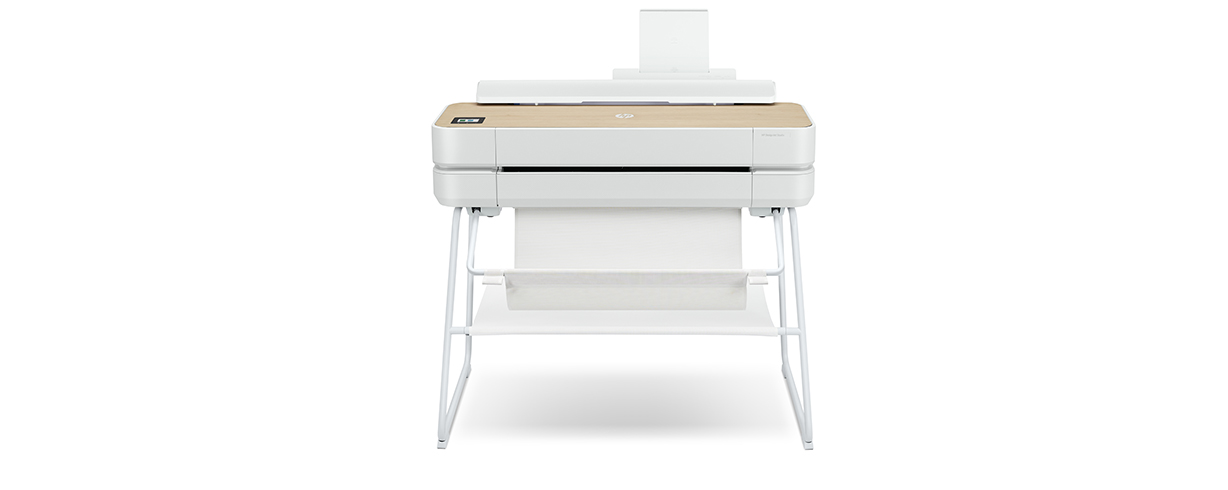
1. HP DesignJet Studio 24-in Printer
Key features:
- A conveniently compact, high-quality design
- User-friendly touchscreen interface
- Fast print speeds
Printer overview:
This inkjet printer from HP is ideal for use in many work and home environments as a convenient, compact printer. You can use it for large-format poster printing in various paper sizes. It also features an easy-to-use touchscreen interface.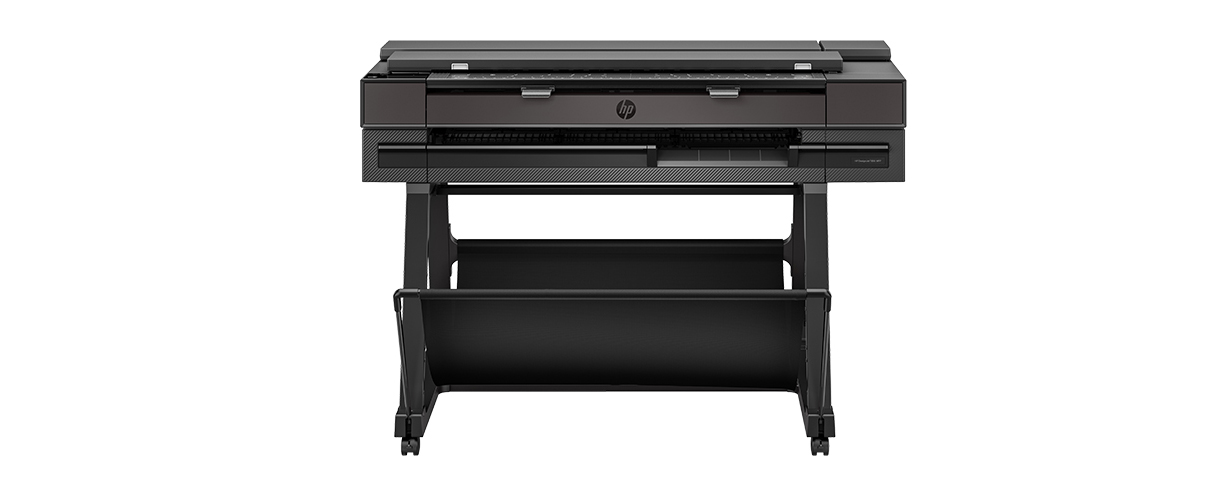
2. HP DesignJet T850 36-in Printer
Key features:
- Print multi-size prints without manually changing from roll to sheets
- Vivid colours and pigment-based ink
- Avoid distractions with fewer ink interventions thanks to 130/300 ml cartridges
Printer overview:
The HP DesignJet T850 printer makes printing in all sizes a hassle-free and effortless experience. Print half-size to D size jobs without having to manually change from roll to sheets. Get high-quality prints with vivid colours, fine-line quality, and excellent small-letter clarity to make any poster stand out. The pigment-based HP Flex Tech Inks are resistant to smudges and highlighter bleed and can withstand exposure to outdoor elements.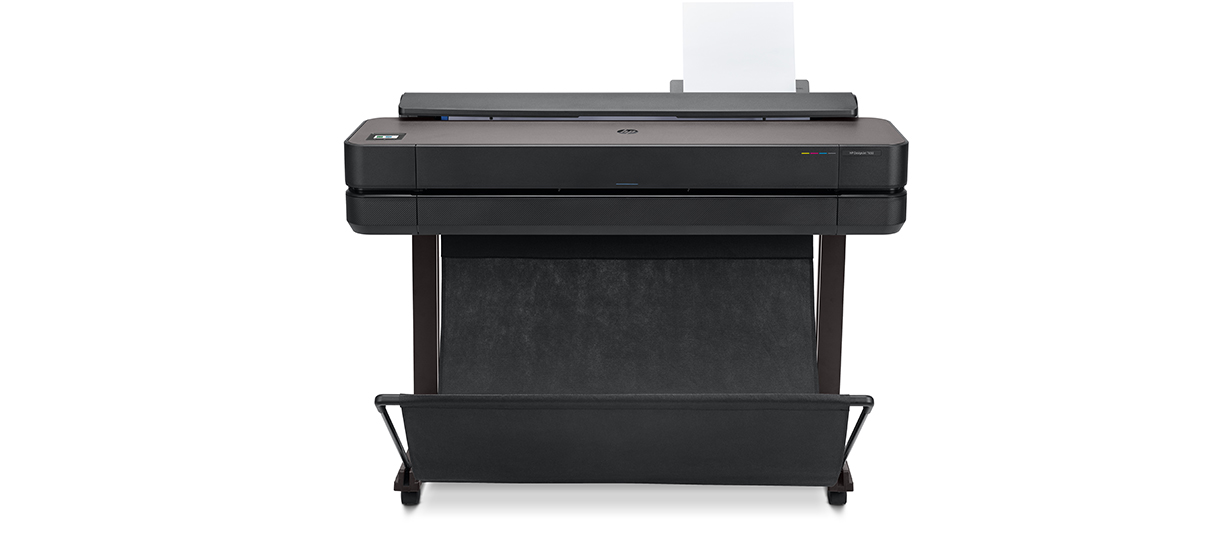
3. HP DesignJet T650 36-in Printer
Key features:
- Compatible with sheets and rolls
- Efficient print speeds
- The smallest printer with a built-in stand
Printer overview:
This 36-inch plotter prints paper sizes up to A1 and has a top print speed of 25 seconds for large documents. It uses dye inks and includes a gigabyte of memory to handle large projects. It's ideal for printing everything from posters and renders to technical drawings.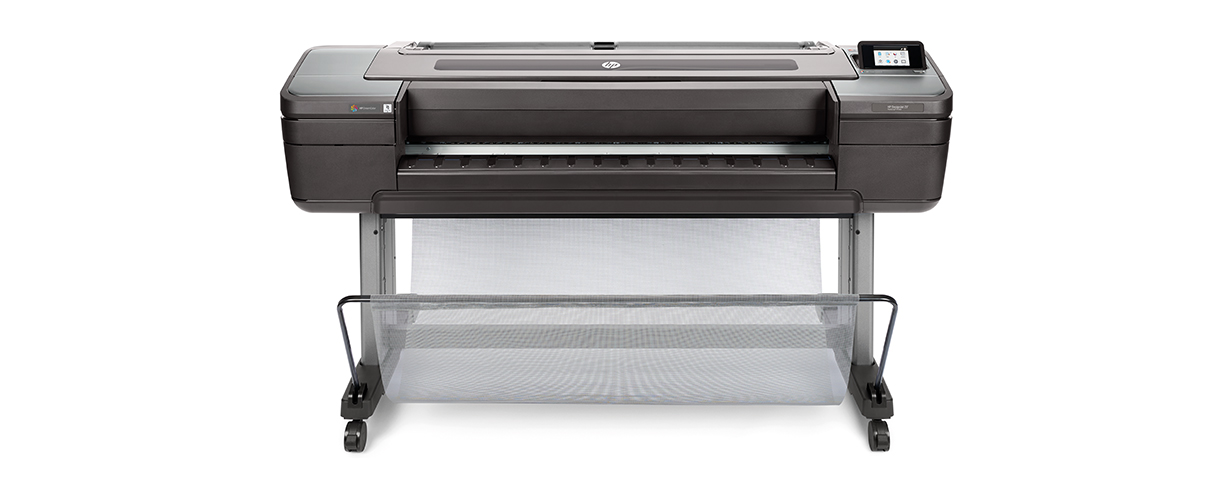
4. HP DesignJet Z9+ 44-in PostScript® Photo Printer
Key features:
- Fast printer speed
- Vibrant colours and rich detail
- Highly secure connection
Printer overview:
If you need a large printer for large-format poster printing, consider this HP DesignJet printer. This particular model can handle print jobs of up to 44 inches and includes a 500 GB hard drive and a touchscreen display. The results are sharp in detail and of superior quality.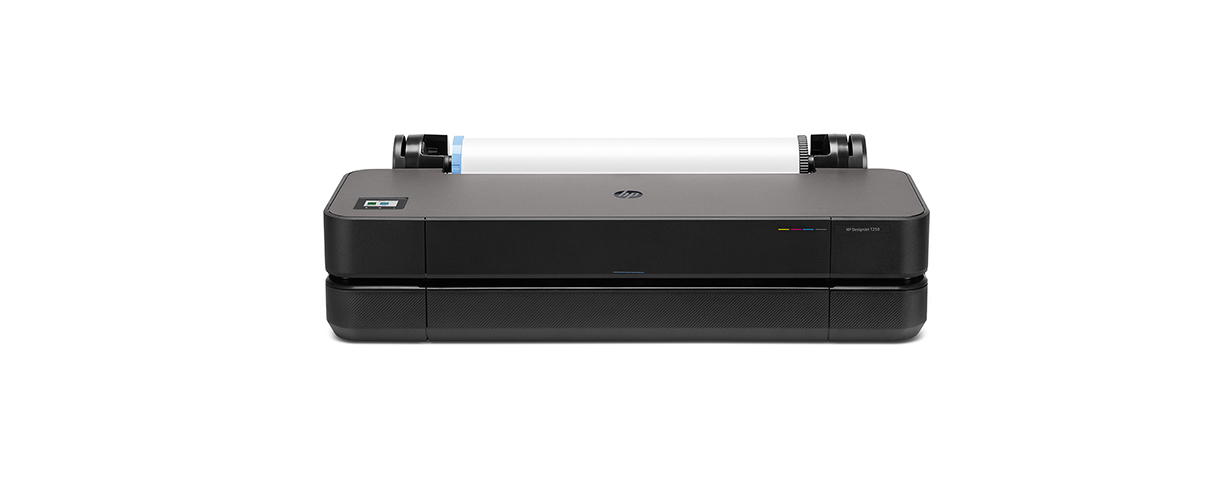
5. HP DesignJet T230 24-in Printer
Key features:
- Automatic paper switching
- Compact size
- Ease of use
Printer overview:
As the smallest large-format printers from HP, the 200 Series DesignJet models feature a compact design that makes them easy to move and meet tight space requirements. You can use it to print A1 to A4 paper sizes or a roll up to 24 inches. You can also print multiple jobs remotely via an app on your smartphone.Reach out to HP to discuss your plotter printer needs
Searching for the perfect poster printers for large-format printing? HP has you covered with a wide range of top-quality options.
-
Read more ...
Large-format printers have become an essential part of the photography industry. Many professionals today rely on these printers because they contribute to the modern photo printing process. They're also widely available and accessible, allowing photographers to easily convert digital images into high-quality, large-scale prints.
The necessity for large-format printing in the photography industry makes it crucial for photographers to purchase the right large-format photo printer to meet their unique requirements. However, with so many models on the market, it can be difficult to make the right selection based on factors like features and cost.
In this article, you'll learn about the various applications of large-format printers in the field of photography and how to find the best large-format printer for photographers. Specifically, we'll list three large-format printers that we consider to be the most reliable in this industry. Photographers can consistently produce professional-grade prints using top-performing functions with the right printer.
The Role of Large Format Printing in Photography
Large-format printing is essential for photographers because of the unique benefits it offers. It allows them to showcase their work on a grand scale, with every detail crisp and visible. The best printers for photographers are the ones that can handle the demands of large-format output without compromising on the fine details that are crucial in photographic work.
The need for high-quality prints in photography
Photographers need prints that offer the best quality through reliable, high-resolution printing processes. A large-format photo printer can print images in some of the highest achievable resolutions with accurate colours to give photographers top-quality prints with every project.How large-format printers help with achieving professional-grade prints
The best large-format printer for photographers will provide professional-grade images while eliminating the need to outsource printing. With the right investment, you can own a high-quality printer that helps you repeatedly produce superior images in larger sizes.Top factors to consider when selecting a Large Format Printer for photo printing
When looking for the best large-format photo printer, there are certain key factors to consider, such as:
a) Capacity to scale an image and print in high resolution
One of the main factors to look for in an ideal large-format photo printer is the ability for you to scale images as needed. Many large-format printers today can print sizes of around 13 inches or wider, with some capable of printing billboard-sized images. In addition to scalability, look for a printer that can print in the highest resolution to ensure consistently great image quality with each print.
b) The colour gamut and print accuracy
You should also seek a large-format photo printer that has the right colour options to accurately print each image. For example, you might want prints with a high level of accuracy when printing the colour yellow, in which case you would want a printer with a variety of reds and greens that can mix to form a range of yellows.
c) Type of ink technology used
The type of ink technology your printer uses could also factor into your decision. For instance, the best large-format printer for photographers today uses inkjet technology that provides great results and peak performance with every project.
d) Connectivity options and paper media compatibility
Your printer should also be able to connect with computers, smartphones, and other devices to allow for convenient printing within your existing tech setup. Additionally, the ideal large-format photo printer should be able to print the specific image format you want to use in photo-editing and printing software.
e) Workflow integration with common photography software
The best large-format printer for photographers will also work with your photography software to allow for seamless workflows. This software could include everything from Adobe Photoshop and Lightroom to Pixlr, Luminar, and other popular types of software.
What are the best large-format printers for photographers?
When you're searching for the best large-format photo printer for you, here are our top picks based on the options and quality they offer:
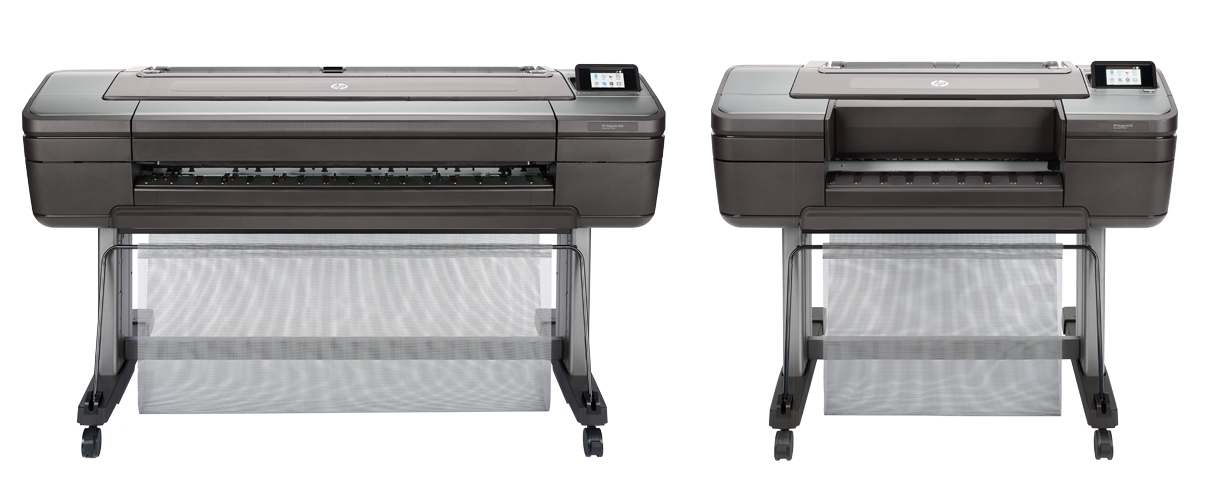
1. HP DesignJet Z Series
The HP DesignJet Z Series printers are among the most dependable HP large-format photo printers available, with multiple options in this line to give you what you need for each print job.
Key features:
- Expansive ink pigment systems of up to 9 pigments
- HP’s dual-drop technology produces a combination of large drop sizes for robust area fills at fast speeds
- Achieve smooth colour transitions with HP Pixel Control
- Large 300-ml ink cartridges
- Professional photo print quality
- Automatic roll feeds
- Touchscreen displays
- Wireless printing option available via HP Click and HP Smart app for iOS and Android
Main advantages to photographers:
Depending on your needs, you can choose from multiple printers in the Z Series that can meet your needs, each with different specs that can help you meet your specific requirements as a photographer. These printers are particularly helpful in producing top-quality professional-grade prints.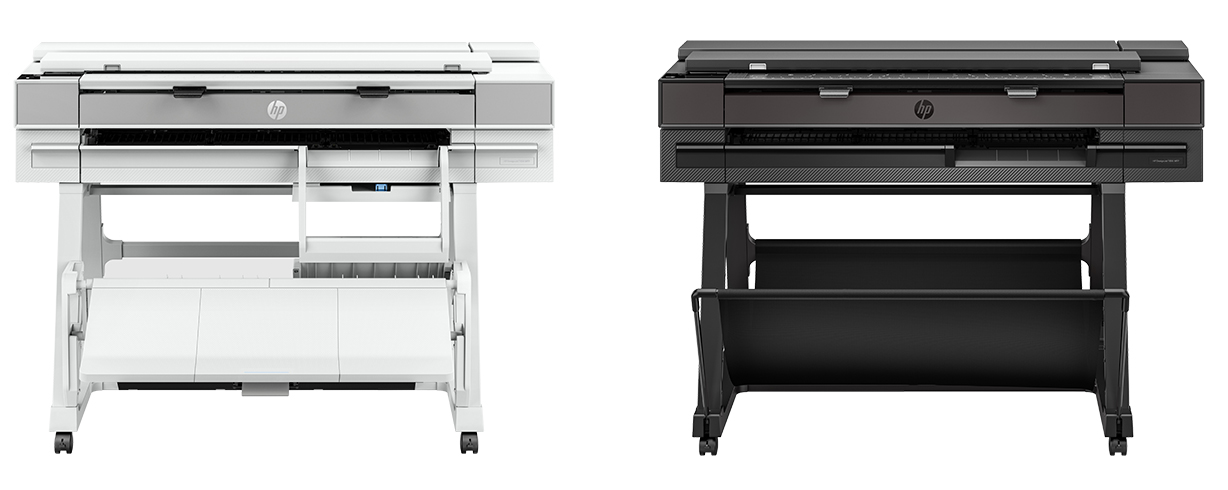
2. HP DesignJet T850/T950
Another great option on the list of the best large-format printers for photographers is the HP DesignJet T850/T950 plotter series, which offer all sorts of benefits for photographers.
Key features:
- 2,400 x 1,200 dpi for superior resolution
- Prints multi-size prints from half size to D size without having to manually change from roll to sheets
- One of the most compact plotters available in the industry
- Many printing options available, including Ethernet, Wi-Fi, USB, and HP Click
Main advantages to photographers:
This large-format photo printer is ideal for printing all types of photos with professional-level quality, along with architect and engineering drawings, and many other projects. It's easy to use and efficient, with excellent printing capabilities that make it ideal for many photography projects.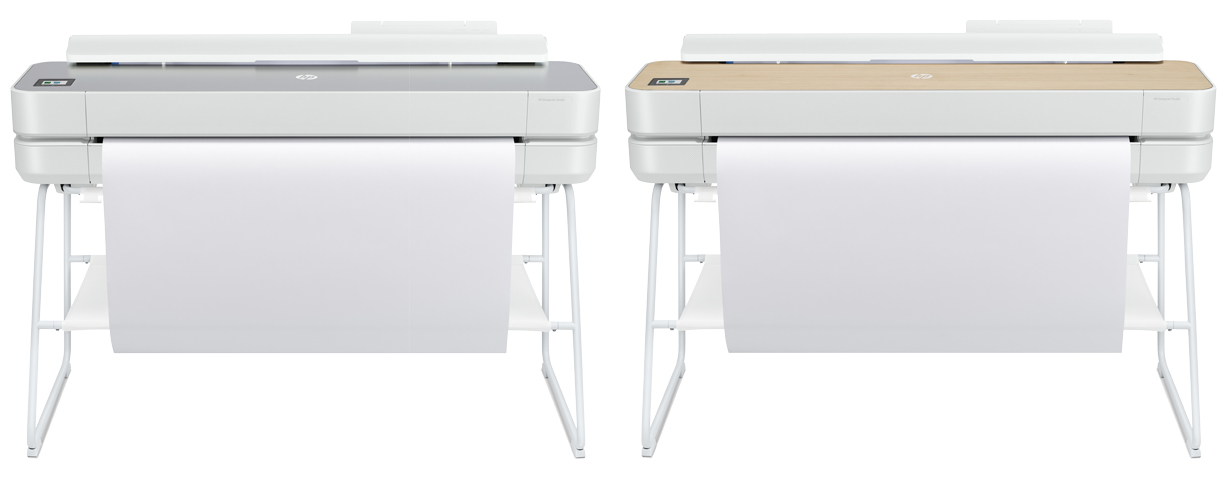
3. HP DesignJet Studio
The HP DesignJet Studio is a popular large-format photo printer that's available in either 24" or 36" models.
Key features:
- Fast print speed up to 26 sec/page on D
- 1 GB of internal memory
- First net carbon-neutral HP DesignJet plotter1
- Aesthetically pleasing wood or steel finish
Main advantages to photographers:
This plotter printer is easy to use and highly accessible, with the ability to print high-quality photos from virtually anywhere with the HP Smart app. It can also print very efficiently, depending on the level of quality of your print. Additionally, it's easy to set up and allows for simple control. That's why it features on many lists of the best large-format printer for photographers.Reach out to HP to meet your large-format photography printer needs
When you're searching for the best-large format printer for photographers, HP’s large-format photo printers can give you everything you need. When you turn to us, you'll be able to choose from a range of reliable large-format printers and plotters based on your unique printing needs.
HP offers reliable customer support and maintenance services
Not only can you find the best large-format printer for photographers with HP, but you'll also have access to top-tier customer support and maintenance as needed to keep your printer running the way it should. Regardless of the issue you might be facing, we're here to help resolve it.If you have any questions about our large-format printers or want help with finding the best model for your photography practice, then contact PSW Paper & Print today
Footnotes
1. HP is reducing the carbon footprint of printing through carbon reduction initiatives such as energy efficiency, reduced packaging, and use of recycled plastics. The HP DesignJet Studio Printer is the first HP DesignJet where HP has offset the remaining carbon impact due to raw material extraction and processing, printer manufacturing and transportation, as well as electricity, paper, and cartridge use in accordance with The CarbonNeutral Protocol https://www.carbonneutral.com/how/carbonneutral-protocol
-
Read more ...
Raster Image Processing software, commonly known as RIP software, is an integral tool for any printing professional looking to deliver the finest quality of prints with the sharpest detail and colour variance. But what actually is RIP software, and how does it work? Even experienced employees, who have worked in the printing industry for many years, may find their knowledge about this topic limited.
There is a fair bit to uncover, even about the basics of RIP software. It is also equally important to know how RIP software differs from other regular printer drivers and how it performs to fundamentally improve your images. With the help of this article, expect to advance your understanding of RIP software and explore our expert tips, plus advice, on using it to fully capitalise on its benefits.
What Is RIP Software?
RIP software is a type of software that offers more control over your print production. It optimises digital images for printing by converting them from their native file formats into high-resolution raster images. With RIP software, you'll have control over every element of your workflow, from image editing to colour accuracy and overall print quality.
You can use it to adjust your image's colour, brightness, and contrast and handle other advanced printing techniques. On a technical level, there is so much you can do with RIP software to generate better prints.
RIP software aims to make printing easier, faster, and more accurate. It bypasses all other programs, allowing your computer to communicate directly with your digital printer. A computer-aided design operator will have access to pre-designed products and an option to create unique, customised print designs. If you would like to produce high-quality prints, RIP software can help you in the following ways:
- Easy manipulation of print (scaling, rotating, cropping)
- Creation of a more efficient printing process
- Automation of duplicate tasks like the placement of multiple files on a single sheet
- Ensuring consistency across multiple printers
- Creation of presets depending on your needs
- Accurate control over the print's colours
Image print RIP software eliminates the complexities of printing while ensuring you achieve superior printing quality.
Key Benefits of RIP Software
Speed
One of the key benefits of RIP software is its speed in processing your prints. The entire process happens within minutes, allowing your company to meet customer demands while retaining high quality. You can process multiple files, easily manipulate your prints, and create presets that speed up your printing process.
RIP software allows you to produce high-quality products by giving you complete control over the print files. You can adjust your print's scaling, opacity, colour correction, dot size, and other features to meet the desired print quality. This is especially crucial when printing large format prints. RIP software can resize your images while maintaining their quality.
Production Efficiency
RIP provides efficient functionalities and features that significantly optimise your company's printing workflow. It supports the simultaneous processing of multiple large files and ensures accurate prints and consistency across various printers.
Therefore, using RIP for your daily printing tasks means fewer reprints, reducing the wastage of paper and ink. This results in more efficient production that saves time and money.
How to Properly Use RIP Software for Printing
RIP software is essential in the production of high-quality printed products. It can be easily installed and used with different printers, including large format printers. Here is how to properly use RIP software for printing and enjoy the numerous workflow benefits.
Prepare Your Files for Printing with RIP Software
Image print RIP software offers an intuitive interface that makes it easy to prepare your files for printing through the following steps.
Set Up Print Parameters
After you launch ImagePrint RIP software, you can set up your print parameters:
- Select your Printer
- Set the Page Size, Quality, Roll/Sheet and Media Type
These settings may vary depending on the printer you're using.
Select Your Media Outlet Profiles
You can take the following steps to select a Printer Profile for the paper you'll use:
Click on Choose by Profile to choose from already downloaded profiles.
Configure Your Colour Management Settings
After acquiring the printer profiles, configure your colour management settings:
- Expand the Printer selection area.
- Select either ImagePrint manages colours or Printer manages colours.
Send Your Files to a Printer Using RIP Software
When you're ready to print, you can send your file to a printer by:
- Click on the Print button at the top of the Dashboard.
- Click OK to confirm your print settings.
Monitor the Printing Process
You can use Spoolface to control and monitor the printing process through the following steps:
- Click on the Printer icon on the top right to open the Job Manager.
- Look at the top Active side to see the job that's printing.
- Monitor the job's progress in the Job Progress area on the right. It'll also show any errors or warnings that may arise.
- Once it's done, it'll move to the bottom Saved side.
- Monitor the printer's current status at the bottom left corner. Error codes will appear here in case the job runs into a problem.
What Are Some of the Advanced RIP Software Techniques?
RIPs offer a wide range of advanced features that enhance the printing process while improving the final product's quality. These features include:
- Colour management: Image print RIP software allows you to create ICC profiles, modify ink capacity, and offer linearisation control. You'll have superior colour management features to help you create accurate prints.
- Halftoning: Creates halftone patterns to ensure high-quality production of continuous-tone images
- Automation: Automate the printing process, including repetitive print jobs such as smart cropping, sizing, multi-page layout, tiling, and more.
- Scaling: Scale images without losing resolution.
- Job management: Manage print jobs such as scheduling and tracking.
With RIP software, you can effortlessly produce high-quality prints that meet and exceed your expectations.
Ensure Print Quality and Production Efficiency by:
Nesting
Nesting allows you to combine multiple files into one print job. RIP software will automatically organise images, shapes, and objects to maximise your print material. It will calculate and figure out the best positions to place them. This ensures efficient use of the space on your print, reducing the wastage of materials.
Tiling
RIP software includes tiling features, allowing you to print larger images without cutting off design elements. When an image is larger than your media size, tiling breaks it into specific sizes your printer can handle. Tiling separates the design image into multiple pieces that can then be printed on multiple pages. Tiling is crucial when you get a job too wide for your printer.
Imposition
When printing your work, RIP software utilises the imposition feature to combine various print works and print them simultaneously. This minimises the printing time and significantly reduces paper waste by maximising the number of orders per impression and thoroughly filling the print sheet. Proper planning and positioning allow your work to be printed effectively and in an orderly fashion.
Reach Out to PSW to Learn More About RIP Software
RIP can greatly affect your printing processes and output quality. It enables creativity, streamlines production, and improves workflow while reducing costs. Therefore, if you would like to increase efficiency and improve profitability, consider investing in RIP software and a high-quality large format printer.
At PSW, we have the right printing solutions for your business. We can help you utilise powerful RIP software to produce high-quality printed products with our extensive range of top-notch large format printers. Contact us today to learn more.
-
Read more ...
Converting GIS data into high-quality large-format prints is critical in effectively communicating spatial information. Whether it's creating maps, posters, or visualisations, accurate and vividly aesthetic representations of GIS data are essential. They facilitate meaningful discussions about geospatial observations and patterns in the GIS and topographic industry.
This article will explore the entire process of transforming GIS data into detailed large-format prints. These documents can empower GIS professionals and topographers to use their GIS data for meaningful analysis. From preparing the data to selecting the right printer and optimising print settings, a comprehensive breakdown of each important step in the conversion process will be discussed in detail.
Why Convert GIS Data Into High-Quality Large-Format Prints?
Geographic information systems (GIS) produce data that experts use in the real world - often for large-scale projects like land development, architecture, and city planning. High-quality and large-scale prints are essential to many workflows. So being able to create them with large-scale printing is a must.
The Link Between Quality GIS Data Output, Communication, and Decision-Making
GIS documents can inform decision-makers and help coordinate teams. Sometimes, they are the reference point for multiple teams working together. The accuracy of the GIS document can determine the accuracy of both decisions and coordinated work.
Understanding GIS Data Conversion
GIS documents are created by combining hundreds to thousands of data points layered into a single document. However, printers require image file types. Therefore, data conversion in GIS becomes an essential part of the process.
Converting GIS Data Into Printable Formats
GIS data must be compressed into a printable format. But that doesn't mean you have to lose detail or accuracy. Large-scale printers typically have the internal storage to handle very large, detailed, printable files.
Common File Formats
Used in GIS Compatibility With Large Format Printers The best file types for GIS printing are vector-based. This means they are lossless when scaled. File format options include:
- PNG
- SVG
- PSD
GIS Software and Tools in Preparing Data for Print
Several software options can be used in preparing GIS data for print—some GIS-specific and some for highly detailed image editing. Be sure the software you use can handle your mass of data without loss and output accurate vector graphics.
Preparing GIS Data for Print
What to Consider When Preparing GIS Data for Large Format Prints
When preparing GIS data for large format printing, you will need to prepare clear visual images that come out in a single printable layer, even if your original design document is a multi-layered mass of data. Consider data cleanup, projection adjustment, and scale adjustments when preparing for print.
Data Cleanup
Determine the exact data to be shown and make sure that data points do not create obscure messaging in your final print.
Projection Adjustments
If there are intentional map distortions, then make sure they are consistent across the document to convey the details necessary for your project.
Scale Adjustments
Scaling GIS data for printing is a critical stage that must be done either before converting your data to a printable form or with vector graphics that scale losslessly after file conversion.
Data Simplification and Generalisation for Improved Print Quality
It may be necessary to simplify and generalise your data to make clearer prints and achieve higher print quality. Too many points will create overlapping indicators that can reduce the clarity of your documents.
Selecting the Right Large Format Printer
The right printer is essential for large-format printing of GIS data. The printer must be able to hold the full size and detail of the document and print with extreme accuracy to provide the best quality print. Large Format Printers Suitable for GIS Data Prints Not all large-format printers have the specs necessary for GIS data or the available paper sizes to meet your needs. Large-format printers must be chosen based on the largest size and highest data quality you will need to print for future projects.
Printer Specifications and Capabilities Required
Printers for GIS large-format documents must have at least 150 dpi, and 300 dpi (dots per inch) is even better. You also need printers with a great deal of internal memory that can hold the large and highly detailed files that you need to print. The ability to handle tiling may also be essential to piece together even larger-sized maps.
Selecting a Printer That Can Handle GIS Data
It is always a good idea to consult printer manufacturers like HP to identify a large format printer that has what it takes to handle the demands of your GIS data.
Optimising Print Settings on a Large Format Printer
Print Settings That Produce Optimal GIS Data Printouts
If your desired GIS map size is bigger than the paper available, you can use tiling or 'poster' settings on your printer. Leave a margin on each page or allow for overlap so you can reconstruct the tiled map with a margin for error.
The Best Print Mode, Paper Type, and Ink Settings for GIS Data Output
Each printer will have specific settings available that will help increase the quality of your GIS data prints. Set your printer to the highest dpi and use the right combination of ink and paper for highly accurate details.
Quality Control and Proofing Prior to Printing Large Format GIS Data
Top Methods for Quality Control Prior to Large Format Printing Quality control depends on:
- Clear and simplified data
- Careful scaling of the map details, key, and indicators
- Test printing
Ensuring Data Accuracy, Visual Clarity, and Overall Print Quality
Simplify your data. Focus on visual clarity, and don't hesitate to use more than one map if you need to represent multiple layers of data. Some even print on sheer drafting pages to allow layer-by-layer overlays. Optimise your markups and keys and convert the whole document into a vector file type before test printing.
The Importance of Test Prints and Proofing
Test printing ensures that your final map is up to your quality standards. Printing a single tile can help you assess if the data is conveyed clearly enough and if the notations meet your needs.
Post-Printing Considerations About GIS Data Prints
How to Maintain GIS Data Prints' Durability and Longevity
Once your GIS document is fully printed, you will likely need it for active use. Large-form GIS printings tend to require protection so they can be used throughout a project but are more difficult to protect due to their large size. You will need to make sure a one-sheet or tiled map is kept flat and protected.
How to Protect and Best Showcase Your Large Format Prints
There are several possible methods to protect your prints.
Lamination
When you have a large enough laminator, you can machine-laminate your GIS print. This will seal two thin sheets of plastic over and around your GIS document, making it safe to pass around and actively use in a busy work site.
Mounting
You can mount your GIS map onto a board, giving it the durability and mobility of rigid backing. You can even seal over the mounted document with a sheet of plastic for safekeeping.
Framing
Place your GIS document in a glass-fronted frame. This can be useful for hanging a large-format map on the wall or even turning it into a live tabletop for better collaborative planning.
Troubleshooting Issues When Converting GIS Data into Large Format Prints Common
Issues Converting GIS Data Into Print Output
GIS printing sometimes requires a little troubleshooting to ensure that the maps come out with the quality, clarity, and utility that you require. Here are a few common issues and how to solve them.
Colour Inconsistencies
The colours on your screen and the colours achieved by a printer are not always the same. A more versatile printer with a wide colour range is ideal, but you may need to calibrate your printer settings to get the best results.
Artifacts
Artifacts can be flaws in the data image created during scaling or file conversion. Scale carefully and always ensure that your data points and key/notations have been translated into a printable format correctly.
Printing Errors
Printing errors can happen. Misalignment of the image to the paper, ink spots, dry ink cartridges, and memory buffer errors can occur. This is where test prints and settings adjustments come in handy.
Solutions and Tips to Achieve the Desired Print Quality
You can get the best quality GIS large-format prints by learning your printer and exploring the printer features with the help of a professional who understands all the printer settings and how each can impact the high-detail quality of your GIS printed documents.
Reach Out to PSW to Receive GIS Map Printing Solutions our HP printer experts will be happy to help you find the best high-quality plotter printer to create your large-scale GIS maps and documents.
-
Read more ...
Exploring the Future of Flexi: Flexi Complete:- In the ever-evolving landscape of design and printing software, staying ahead of the curve is paramount. Enter Flexi Complete, the latest offering from SAi, promising a suite of cutting-edge features to revolutionise the way professionals in the industry work. Let’s delve into what makes Flexi Complete a game-changer for designers, printers, and sign makers alike. Flexi Complete is the same Flexi you know and love but with a fresh new look and a bevy of improvements. Let’s see what’s new.
A Better User Experience
One of the standout features of Flexi Complete is its commitment to providing a seamless user experience. Flexi Complete brings a new look to the intuitive interface of Flexi. Designed to streamline workflows, users can navigate the software with ease, saving both time and effort. Whether you’re a seasoned professional or just starting out in sign making, DTF DTG, direct-to-vinyl, or other wide format printing applications Flexi Complete’s user-friendly design ensures that you can hit the ground running from day one.
Enhanced Design Capabilities
Flexi Complete empowers designers with enhanced capabilities to bring their creative visions to life. With an array of new tools and functionalities at their disposal, users can push the boundaries of design like never before. From advanced vector drawing tools to dynamic effects and filters, Flexi Complete offers unparalleled flexibility and control, allowing designers to unleash their creativity without limitations.
Optimised Printing Workflow
Efficiency is key in the world of printing, and Flexi is engineered to optimise every step of the printing workflow. With robust finishing tools and advanced color management features, users can ensure that their prints are accurate and of the highest quality, every time. Whether you’re producing large-scale signage or intricate graphics, Flexi’s printing capabilities are second to none.
Seamless Integration
Flexi seamlessly integrates with existing workflows, making it easy to incorporate into your existing setup. Whether you’re using other design software, RIP software, or hardware devices, Flexi plays nice with others, ensuring a smooth transition and minimal disruption to your operations. Flexi Complete offers a total package from design to production, including a powerful 64-bit RIP to give users a seamless workflow from start to finish.
Commitment to Innovation
At its core, Flexi Complete is a testament to SAi’s commitment to innovation. With a dedication to pushing the boundaries of what’s possible, SAi continues to raise the bar in the world of design and printing software. Flexi Complete is not just a product but a reflection of SAi’s ongoing mission to empower professionals in the industry with the tools they need to succeed.
With its intuitive interface, enhanced design capabilities, optimised printing workflow, seamless integration, and commitment to innovation, Flexi Complete is made to revolutionise the way professionals in the sign and print industry work. Whether you’re a designer, printer, or sign maker, Flexi Complete is the ultimate tool to bring your creative visions to life.
About SA International (SAi).
Headquartered in Salt Lake City, Utah, SA International (SAi) is recognised as the global leader in providing software solutions for the sign making, digital printing, textile, and CNC machining industries - from design to production. SAi's Flexi family of software products rank as the world's number one software for sign making and digital printing, outselling all competitors combined. Flexi is found on more wide-format printers than any other software. In addition, the company is one of the leaders in the CNC machining and router markets with its EnRoute CAD/CAM software.
SAi has a large and loyal network of resellers around the world and has over 250,000 customers in more than 150 countries. SAi enjoys strong OEM relationships with industry-leading manufacturers. In addition to its USA headquarters, SAi has offices in Brussels, Belgium, Sao Paulo, Brazil, Shanghai and Hong Kong, China, Pune, India, Tel Aviv, Isreal and Tokyo Japan.
-
Read more ...
In a world where environmental consciousness is increasingly important, sustainable alternatives to conventional materials are gaining more significance. This is especially true for the advertising industry, where the demand for PVC-free films has steadily grown in recent years. Neschen, as a renowned manufacturer of high-quality printing films and coatings, has in an early stage already embarked on the development and production of PVC-free films to meet the rising demand for more environmentally friendly solutions.
A sustainable development in advertising technology
The demand for PVC-free films has significantly increased lately. Companies, especially large global brands, are increasingly focusing on sustainability issues. Neschen, as a pioneer in sustainability in the advertising technology industry, has been offering PVC-free alternatives for some time now to meet the growing demand for environmentally friendly solutions. Explore Neschen’s wide range of PVC-free films here: Neschen Green Graphics
Types of PVC-free films
Neschen offers various PVC-free films, including polyolefins such as polypropylene (PP) and polyethylene (PE), bio-PE, and polyester (PET). PP and PE films are cost-effective alternatives with robust product properties for UV printers. Bio-PE films, with an organic content of over 50%, are currently not printable, but we are working on that. Our PET films, made from polyethylene terephthalate, offer optimal performance and are optimized for printing with latex and UV inks.
Advantages of PVC-free films
Compared to conventional PVC-based products, PVC-free films (e.g., easy dot® PET matt L-UV or UVprint PP easy dot® matt) offer a range of benefits. They are dimensionally stable, do not deform, and have almost no shrinkage. Transparent PVC-free films (e.g., easy dot® PET transparent L-UV) provide significantly better clarity and are also more environmentally friendly as they require up to 40% less material, thereby producing less waste. Neschen aims to offer high-quality PVC-free films that are not only environmentally friendly, but also provide top performance and quality.
Challenges and solutions
While the use of PVC-free films brings many advantages, it also presents certain challenges. For example, dimensional stability can make processing more difficult. Through innovative solutions and profound expertise, Neschen assists its customers in exploiting the benefits of PVC-free films.
“The development and production of PVC-free films are not only a commitment to the environment for us at Neschen, but also an opportunity to develop innovative solutions that are both environmentally friendly and of high quality.” – Moritz Weber, Head of Marketing, Neschen.
Support measures for the Use of PVC-free films
Neschen actively advocates the promotion of PVC-free films. By participating in various project groups and initiatives, the company strives to encourage distributors and end customers to increasingly opt for environmentally friendly alternatives. Emphasizing the benefits of PVC-free films, such as significantly better environmental performance and cost savings in disposal.
Future outlook
The future of PVC-free films looks promising. With increasing demand and rising production volumes, market prices for PVC-free films are expected to close the gap with PVC-based products.Neschen will continue to strive to offer innovative and environmentally friendly solutions to meet the growing demands for sustainability. As a leading manufacturer of PVC-free films, Neschen is well positioned to drive the development and use of these sustainable materials forward.
Conclusion
The use of PVC-free films in the advertising technology industry is a significant step towards a more sustainable future. This concerns us all! Neschen has established itself as a leading manufacturer of high-quality PVC-free films and actively contributes to reducing the ecological footprint and minimizing environmental impact. Through continuous innovation and commitment, Neschen will continue to play a leading role in the development and production of environmentally friendly printing films.
-
Read more ...
HD Apeiron/42, the new contact-free art scanner from Contex, uses unparalleled technology to accurately digitise media. With the market’s most realistic image quality, full light control and a unique ability to emphasize details, the scanner is ideal for fine art, fragile artifacts and more. This art scanner is another innovative solution from the world leader in large format scanning.
Meeting the highest FADGI image quality level with four stars as the first of its kind, and also reaching CRI levels above 98 makes it clear that this scanner is head and shoulders above the rest.
Featuring a clearance height of 10 inches (254 mm) and a focal plane of up to 5.1 inches (130 mm), it also enables scanning of thicker media, such as framed artwork.
“When you’re working with what could be priceless originals, only the best is good enough,” says Jacob Bendix, CCO and VP of Global Sales & Marketing. “HD Apeiron/42 beats the competition on all parameters, which means our entry into the art scanner space will open up new opportunities for our customers. The technology we have put behind digitizing art and other media is simply better and more effective.”
Unparalleled technology and light control
Six quad-linear Fujifilm lenses with Toshiba colour CCDs capture all details in up to 1200 dpi optical resolution – twice the competition’s image quality.
Patent-pending laser-controlled camera adjustment and motorized focus adjustment make focusing easy as well.
“The way we integrated the precision timing belt for the table transmission makes HD Apeiron/42 equally as precise as our other scanners which we have further developed and improved over the last 20+ years,” says Søren Thuun Jensen, CTO and VP of R&D. “Together with the lighting in the scan module which is uniformly illuminated in all three dimensions, it is, simply put, a superior scanner.”
The lamps in HD Apeiron/42 recreate the natural daylight spectrum using cutting-edge LEDs with TRI-RTM technology. This, plus the clever design of LED strips mounted in elliptical reflectors, results in correct and uniform colors – and no distance fading.
Preserving the unique surface sensations of an original in the scanned image is also easy. HD Apeiron/42 offers four different lamp positions, and depending on their position, the lamps provide different types of highlights and shadow effects – especially if paired with the 3D option. In comparison the competition has only one lamp position.
Museum-correct light with no UV/IR radiation conserves the art.
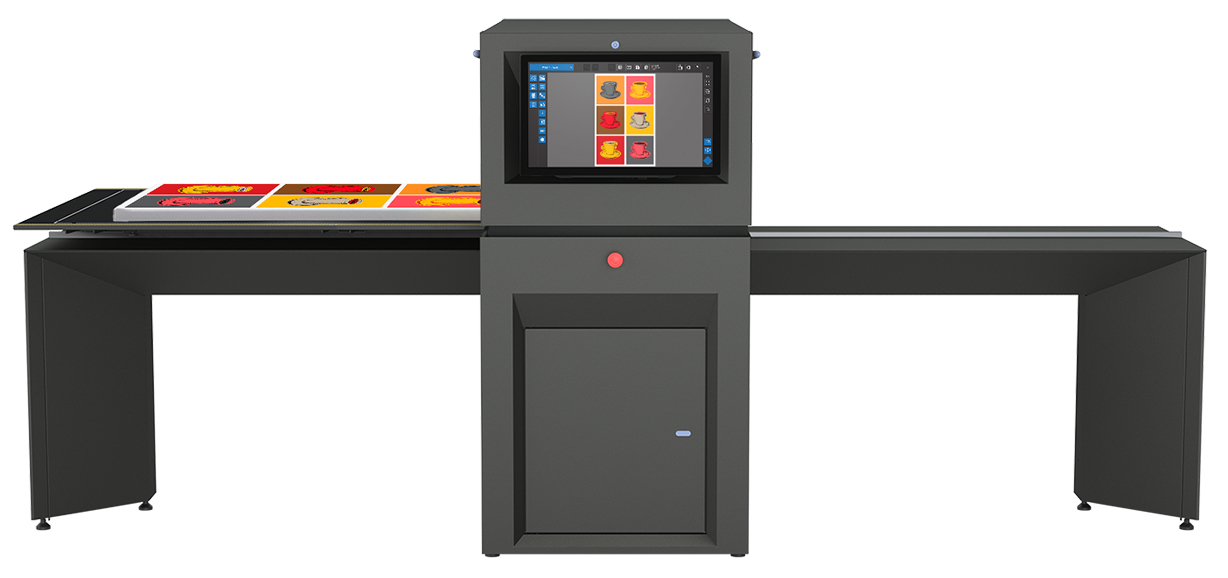
Fast, flexible and fitted
HD Apeiron/42 is the fastest contact-free large format scanner on the market. A flexible solution; it improves workflows while ensuring superior image quality.
The hardware is designed to support correct ergonomics; this includes an adjustable arm with the touchscreen, so the operator doesn’t have to hunch over.
Simple scanning
Award-winning Nextimage software forms the operational foundation of the scanner. While the Nextimage Apeiron software (included) itself is complex, using it is as simple as:
- Choosing between presets (or making and saving your own)
- Positioning the table and the focal plane
- Scanning
All required parameters are readily accessible on the touchscreen rather than hidden behind tabs or dropdown menus. A variety of post-scanning options also allow the user to adjust parameters and effects, if desired.
About Contex
As the world's largest developer and producer of large format imaging solutions, Contex leads the market with innovative technology and advanced scan and copy software applications. Sold worldwide in more than 90 countries, Contex solutions are recognized in a wide range of industries for reliability, value, high performance, and superb image quality.
-
Read more ...
Summa nv, a leading company of high-end cutting plotters and finishing systems, has released a new version of their GoProduce software, GoProduce Flatbed Edition 3.0. This software is explicitly tailored to Summa’s flatbed cutter range, the F Series. As a result, the in-house developed software ensures optimal utilisation of the flatbed cutters and efficiency in customers' production processes.
GoProduce Flatbed Edition
GoProduce was originally released in 2019, as the first software module within Summa’s GoSuite platform. This was followed by a major upgrade to version 2.0 in 2020. Summa always strives to deliver innovative and cutting-edge solutions, so the major upgrade was done to stay up-to-date with the latest technologies. Out of the same aspiration, GoProduce Flatbed Edition 3.0 is born. The specification ‘Flatbed Edition’ has now been added to the software name to make a clear distinction in the software available, as Summa also has production software for their L Series laser cutters called GoProduce Laser Edition.
The software comes with every new F Series and is easy to install. With its intuitive interface and easy navigation, the software is user-friendly and users quickly find their way around. For users who want to get the most out of their cutter and workflow, a Pro Pack is available that unlocks additional features such as Barcode functionality, Hot folder support and Twin X workflow.
General great things about GoProduce:
- Material manager: Library of materials and their optimised settings. There is already a whole lot of them included but you can also add new ones manually.
- Action sets: there are standard action sets or you can custom make them, perfect to optimise the workflow for your way of working.
- Backside cutting: it’s possible to cut the unprinted backside of the material, perfect for cutting packages, as that way the tool does not damage the design.
- Sorting: Optimises the cutting path, making the machine more efficient and makes your output faster.
- Barcode functionality Pro Pack: The barcode functionality reads the printed barcode and automatically identifies the job to obtain the necessary cutting data from the computer.
More Powerful, More Connected, More Enhanced
The new GoProduce Flatbed Edition 3.0 is now available, and it has some great new features:
- Powerful 64-bit software: Not only does the software run faster, but there is now more working memory, making it operate more efficiently.
- Connected media handling: It integrates the flatbed cutter smoothly with peripherals to create an efficient automated workflow, using our GoConnect software integration.
- New predefined action sets for automatic feeder support.
- New logging features for better support.
The V3 software is optimised for routing jobs. It comes with new routing capabilities that are perfect for cutting out shapes more precisely. They maximise productivity when processing wood, acrylics, and plastics. The features supporting this are:
- Automatic detection of drill hole placeholders.
- Lead-in or lead-out for the milling path: It can now automatically start and end outside of the shape. There are two possibilities to do this using either a perpendicular lead-in or corner lead-in.
Empower Your Machine Precision
Randi Kerkaert, Product Manager at Summa, reflects on the importance of the upgrade for our customers: “I'm excited to see how this major software release will take our customers' production processes to the next level. We’re not just updating features; each major upgrade enhances the way our users interact with their F Series flatbed cutters and helps to maximise the productivity of their equipment. With GoProduce Flatbed Edition 3.0, we're once again raising the bar for what users can achieve with our software."
The GoProduce Flatbed Edition 3.0 software is available with every new F Series and as a paid upgrade for existing users. A 30-day trial allows existing F Series users to discover the new features in the software: https://www.summa.com/en/support/software-firmware/
-
Read more ...
Onyx Graphics, Inc., a pioneer in wide-format digital printing solutions and RIP software development, is set to preview ONYX 24 and unveil the much-anticipated ONYX Sync at FESPA 2024. Version 24 introduces features such as automated multi-layer printing, seamless mobile device integration, and advanced print quality assurance. These innovations continually demonstrate the company's commitment and capability in powering the next generation of automated printing solutions for print operators and businesses worldwide.
Introducing ONYX 24: Elevating Print Workflow Efficiency
ONYX 24, the company’s latest release in RIP software, introduces major optimisations that address key industry challenges in print automation and efficiency. Developed with feedback from industry professionals, version 24 achieved major breakthroughs, including automated multi-layer preparation for spot colours and effects, mobile spectrophotometer calibration, and embedded workflows for colour verification.
This release marks a significant leap forward, with end-to-end automation that transforms integrated print management. Key technical highlights include:
- Easy Multi-Layer Printing: Achieves effortless multi-layer printing through automated generation of layers based on spot colours, varnish, or other special printing effects. This feature streamlines complex file preparation by eliminating manual separation of elements across layers, saving valuable time while ensuring quality.
- Wireless Support for NIX Spectro Devices: Introducing native support for the NIX Spectro 2 and Spectro L spectrophotometers via Bluetooth. This new wireless connectivity powers the next generation of colour measurement, enabling wireless reading and calibration at an affordable price.
- Colour Accuracy Verification: Users can now add a ColorCheck Baseline Swatch to newly created profiles to verify the accuracy of future prints. This is achieved by incorporating a ColorCheck Strip at the time of profile generation, subsequently establishing a quality baseline for printers. When future print jobs utilise this process control feature, the same patches can be measured in order to verify that the prints continue to adhere to colour quality benchmarks, allowing for the detection of drift over time and to prevent errors.
"ONYX 24 marks a major milestone in our commitment to address practical challenges faced by the printing industry," said Matt Crawford, CEO of Onyx Graphics, Inc. "With this release, we're fully ready to roll out our most innovative RIP solutions to our European customers, empowering our users with the tools they need for unparalleled efficiency and success.”
ONYX Sync: The Future of Print Shop Automation
ONYX Sync is the latest REST API developed to enable print service providers (PSPs) to grow and automate their businesses. Our solution enables print shops to fully streamline and align their print production processes with various business tools, and to connect ONYX Thrive with users’ existing business management software to enhance workflow efficiency and productivity.
This API integration empowers print shops to eliminate manual tasks, minimise operational errors, and conserve essential production time, resulting in advantages such as:
- Real-time production feedback and status updates through an intuitive API.
- Seamless integration with existing business management software, eliminating manual intervention.
- Automated job submission and management tools for increased efficiency and scalability.
- Enhanced communication and job status notifications for better customer service.
“ONYX Sync drives tremendous sustainability gains through automated production efficiency,” said Crawford. “The seamless integration with ONYX Thrive optimizes workflows to minimize waste, create circular material usage, and provide robust analytics for carbon and environmental impact management. By embracing API and IoT technologies to reduce print resource intensity, we firmly believe ONYX Sync creates a greener model for the future.”
About Onyx Graphics, Inc.
Leading the market since 1989, Onyx Graphics is dedicated to helping customers increase productivity, reduce costs, and gain a competitive edge with superior software solutions for the print industry. Innovative, productive, and delighted customers around the globe help motivate the company to develop and enhance its leading-edge technologies. Global channel partnerships and longstanding relationships with printer manufacturers position Onyx Graphics as a market leader in powerful, reliable, large-format printing workflow and print business software solutions.
Skip to Content
- Create an Account
- Offers for you

+44 (0) 1527 853 136



